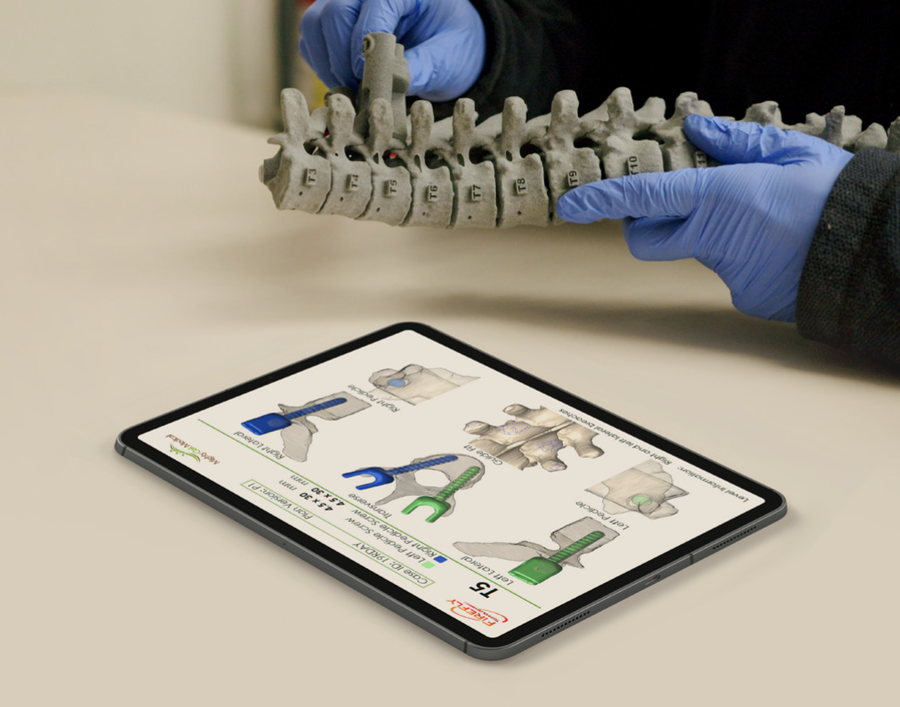Colorado-based med-tech company Mighty Oak Medical has announced a partnership with HP. This partnership will see Mighty Oak Medical using HPs Jet Fusion 5200 3D printers to develop 3D printed healthcare applications.
Mighty Oak Medical is currently in the process of manufacturing various applications, one of which is its flagship product FIREFLY. FIREFLY is a patient-specific pre-surgical planning and navigation platform that utilizes 3D printing technology. Mighty Oak has obtained FDA clearance and a CE mark for the 3D printed medical models and surgical guides used in FIREFLY, providing significant benefits to patients, surgeons, and the healthcare system.
“It was important for us to maintain our focus on the spine and develop innovative solutions that make surgical procedures safer and more efficient,” said Heidi Frey, President at Mighty Oak Medical. “We have always viewed 3D printed, patient-specific solutions as an ideal way to achieve those two objectives, and now, thanks to HP’s 3D printing technology, the healthcare industry is undergoing a massive transformation in terms of the solutions, patient experience, and outcomes new 3D printed medical devices can provide.”
FIREFLY navigation system improves spinal fusion surgery
Mighty Oak Medical has over a decade of experience in using 3D printing to improve spinal devices. It developed the FIREFLY navigation system, which uses 3D printing to create custom guides for spinal screws. The FIREFLY solution enhances precision and safety in spinal fusion surgery by offering surgeons accurate, millimeter-level pre-surgical planning using 3D virtual renderings of patients’ spines. Surgeons utilize 3D printed anatomical models and disposable guides for efficient and secure drilling, tapping, and placement of pedicle screws, resulting in improved success rates and reduced stress during spinal surgeries. By incorporating HP’s industrial Multi Jet Fusion technology, FIREFLY optimizes printing turnaround time, enabling a higher level of personalized care for a greater number of patients.
Mighty Oak Medical has achieved notable efficiencies and enhanced accuracy in pedicle screw placement since integrating HP’s Jet Fusion 5200 3D printers into its factory. With a screw placement accuracy of 99.7%, the use of patient-specific guides eliminates intra-operative radiation exposure for surgical staff and patients, while also reducing maintenance and technician costs. HP’s 3D High Reusability PA 12 material provides superior strength, detail, and surface finish, enabling surgeons to easily identify anomalies, gaps, and markings in the operating room (OR).
“Mighty Oak is currently leading the charge towards a more advanced medical device and orthopedic industry with its FIREFLY solution,” said Greg Elfering, Head of Americas Go-to-Market, HP Personalization & 3D Printing. “We are excited to partner with Mighty Oak to maximize the benefits of HP’s 3D printing solutions for healthcare applications. By minimizing costs, enabling personalization, and improving efficiency and accuracy of care for patients, Mighty Oak and HP are demonstrating how the power of innovation can positively impact patients and the healthcare industry.”

Partnerships to accelerate the adoption of 3D printed healthcare devices
3D printer OEM Stratasys, and Ricoh, a Japanese multinational electronics company, announced a partnership this year. This collaboration aimed to create 3D printed realistic anatomical models that enable visualizations of a patient’s anatomy. Stratasys’ Patient-Specific 3D Solutions aid medical professionals in effectively planning and simulating complex surgeries while improving communication among the care team, the patient, and their family. This novel solution combines Stratasys’ expertise in 3D printing, Axial3D‘s Segmentation-as-a-Service solution, and Ricoh’s precision additive manufacturing services, providing a comprehensive offering in the field.
Medical device service provider BAAT Medical and Belgian contract manufacturer Amnovis collaborated to provide a novel and efficient process for 3D printed medical devices. Leveraging their combined knowledge, the two companies developed a comprehensive process that covers the entire journey from initial design to manufacturing and validating end-use devices. This collaborative effort aimed at offering medical device start-ups and OEMs faster time-to-market, ultimately leading to enhanced patient outcomes.
What does the future of 3D printing for the next ten years hold?
What engineering challenges will need to be tackled in the additive manufacturing sector in the coming decade?
To stay up to date with the latest 3D printing news, don’t forget to subscribe to the 3D Printing Industry newsletter or follow us on Twitter, or like our page on Facebook.
While you’re here, why not subscribe to our Youtube channel? Featuring discussion, debriefs, video shorts, and webinar replays.
Are you looking for a job in the additive manufacturing industry? Visit 3D Printing Jobs for a selection of roles in the industry.
The FIREFLY solution streamlines the spinal surgery process. Image via Mighty Oak Medical.



